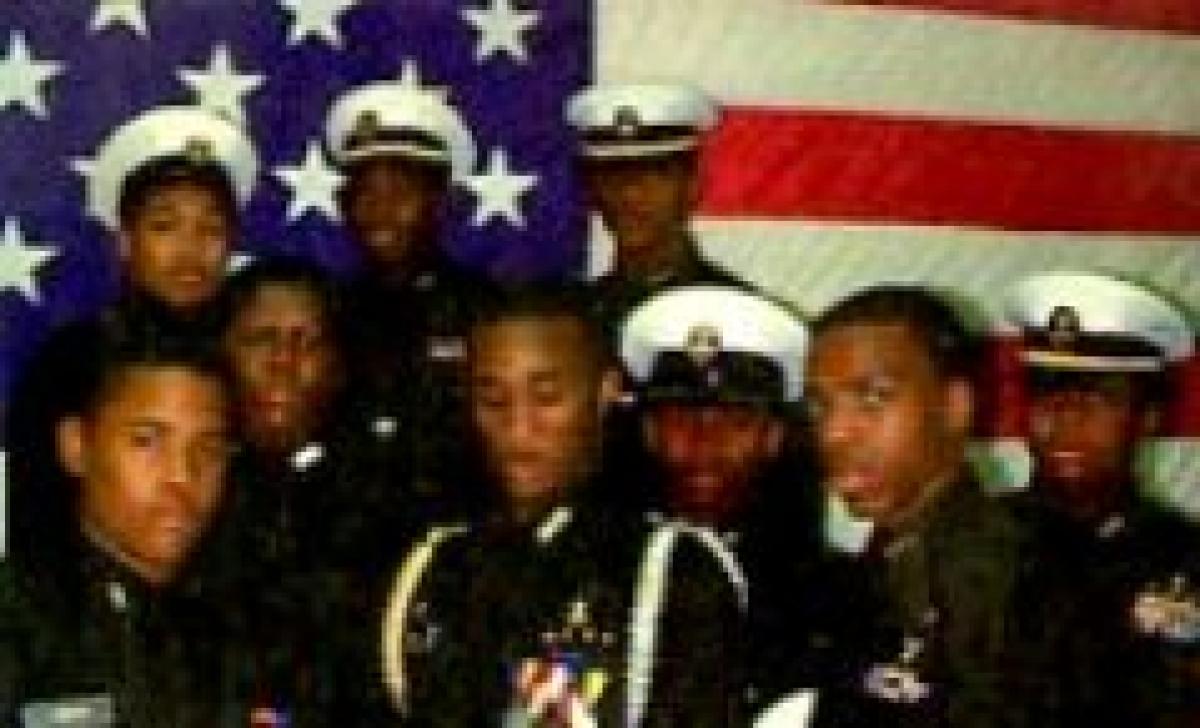With the end of the Cold War and the onset of a new world order, the United States is faced with many challenges. Exceeded in importance only by the quest for the nation's economic health is the deplorable state of American education. We need only watch the evening news to become painfully aware of the shortcomings of public education, particularly in the inner city, and to witness the terrible ramifications of that failing struggle.
One small foothold on the beachhead to recovery has been realized in a new program in Baltimore called the Walbrook Maritime Academy (WMA). With start-up funding provided by the Department of Defense (DOD), a staff of U.S. Navy and Coast Guard personnel, and a military academy environment in the midst of a troubled inner-city neighborhood, this educational experiment in many ways resembles a military operation despite its extremely important social objectives.
Located in the former vocational training area of Walbrook High School in the heart of Baltimore, this new school (the doors opened in September 1994) has a distinctly nautical feel: Signal flags hang from the overhead, helms and charts adorn the bulkheads, and engine-order telegraphs, cleats, and bollards are scattered about.
The cadets (as the students are always called) are, for the most part, young people who would be out on the street, out of educational options, were it not for WMA. A few of the cadets are in the program because they specifically requested admission out of an interest in the military, but the great majority are enrolled because they meet one or more of the following criteria:
- Involuntary disenrollment from other schools
- On probation for criminal violations
- Past the age of mandatory education
They come to the program with a history of poor attendance, worse punctuality, and frequent disciplinary violations. One in ten has been the victim of a gunshot wound, many have one or more children of their own, some are receiving substance-abuse counseling, and most are recipients of one or more forms of government welfare.
The instructors consist of nine retired officers and enlisted personnel from the Navy, Marine Corps, and Coast Guard. Although all are retired from active duty, they wear their uniforms while teaching English, social studies, mathematics, and science as well as courses in naval science and maritime technology.
The Department of Defense provided a generous grant to cover start-up costs such as plant renovation, textbooks, computers, classroom furniture, and security measures. Additional funding from the Department of the Navy, and from a private foundation, are temporarily covering instructor salaries. The Navy also is providing uniforms for the cadets as well as various modem training programs and equipment.
Establishing an inner-city school where military discipline and nautical traditions are central themes is a revolutionary concept, but solving the myriad problems associated with such an undertaking has been an evolutionary process. Since most of the young people enrolled at WMA bring with them many disadvantages and inadequately developed academic skills, it has taken a great deal of innovation and much trial and error to counter these obstacles.
Because there is a great deal of diversity among the students, one of the earliest lessons learned was that what works for one student will not necessarily work for another. The WMA staff has met this challenge with a wide variety of tactical approaches involving both positive and negative motivations and a strategy that approximates the "tough love" approach recently advocated by child psychologists. Military discipline is enforced by such measures as an after-school detention program and the withholding of privileges, while more democratic measures such as a student congress give the cadets a role in decision making.
Liberty Call. Early in the program, head calls became an area of serious concern. Traditional high schools issue hall passes, but this method proved very disruptive at Walbrook and the heads turned into social gathering places for the cadets. To solve the problem, WMA sacrificed the last ten minutes of each 90-minute class to hold a "Liberty Call." During this period, cadets can visit with friends on the academy grounds, talk with instructors, and use the head. This is the only time—excluding emergencies and lunch time—that cadets are given access to the otherwise locked heads.
At first, cadets reacted with threats of intervention by parents , doctors, and congressional representatives; after a short time, however, they settled into the routine.
Cadet Hall of Fame. One of the more positive approaches has been the establishment of a Cadet Hall of Fame. Every month the staff meets to select five "Cadets of the Month," one from each homeroom. They are honored at a special ceremony held with the entire battalion and invited guests. Each cadet is presented with a certificate mounted in a special leatherette folder with a gold-embossed seal of the U.S. Navy on the cover, a special ribbon to wear on their uniforms, and a set of dog tags that read "WMA Cadet of the Month." Pictures of the honorees appear in The Helm (the academy newspaper) and are mounted as a permanent display at the Academy's Quarterdeck. "Cadets of the Quarter" are similarly honored, and there is a final selection for "Cadet of the Year."
The staff has tried to strike a balance between recognizing too many students while at the same time providing enough opportunities to gather in those cadets who might think that they didn't have a chance. The month-quarter-year approach was designed to counter a rest-on-your-laurels attitude, and the staff has been careful to choose, whenever possible, cadets popular among their peers as a way to dispel any "geek" image.
The Helm. The staff created the Academy newspaper as a way to help counter the traditionally low self-esteem held by inner-city youths. They see their names in print and their achievements listed. Many of the cadets have responded positively to this approach. A sizable crowd always gathers when it comes off the press, with cadets often asking, "Did I make The Helm this week?" Color versions are posted around the Academy, and enough monochrome versions are printed to give every cadet a copy.
The Anchor Pool. Poor attendance and tardiness are big problems in the inner city. Each morning at precisely 8:30 a.m., the beginning of the school day, the director visits each classroom and hands out an individually numbered ticket to each cadet seated at a desk.
The cadets write their names on the tickets and drop them in a collection box. Quarterly drawings have included prizes such as a 13-inch color television set. Cadets are reminded frequently that the more tickets they earn, the better their chances. On days when attendance is traditionally low—the last day before a vacation or a bad-weather day—two or even three tickets are handed out to individuals as incentive awards.
Ropeyarn Sunday. As an added incentive to good performance, the staff periodically holds stand-downs during which cadets put aside their books and are given free access to movies and refreshments, plus table-tennis and chess tournaments. The activity, however, is available only to those cadets who have earned it. The others receive extra military instruction, known infamously as EMI. The cadets understandably are motivated to qualify for "Ropeyarn Sunday" rather than the boot-camp like atmosphere of EMI.
Communications. Despite the oft-heard comment that "parents today don't care," one of Walbrook's most effective means of achieving desired results has been frequent communication with parents and guardians. There is no denying that some parents/guardians do not care, and that others have lost effective influence over their children for a variety of reasons. But it also is true that ten telephone calls in a given day will result in modified behavior the next day in eight or nine of the cadets whose parents were called.
These are just a sampling of the many innovations the staff has employed in its battle against the problems inherent in the inner-city environment. Many others have been tried; some succeeded, some failed abysmally.
All were born of a spirit that accepts no substitute for victory. The instructors have traded their guns and missiles for more subtle weapons. Armed with their passion for excellence, the resilience and sense of humor that got them through Vietnam and the Cold War, and their genuine caring for the plight of these young Americans who are the innocent refugees of another kind of war, these "retired" military men and women are not ready to give up the fight.
Size is one of the Academy's most important characteristics. When schools were modeled on the American factory earlier in this century, societal problems were very different from those of today. Teachers surveyed as recently as the 1950s listed among their top five concerns problems such as "students butting into line" and "gum chewing." Today, the top five include drugs, violence, and teen pregnancy—and such problems cannot be dealt with in the large factory-like setting that typify modern schools.
Today's student needs more supervision and personal attention than can be provided in the traditional school environment. All of the measures described here—and many more—are achieving results because the Academy is a manageable segment of a much larger and unwieldy inner-city high school. Innovation can take root and standards can be established, monitored, and enforced. Management tools are carried out not by impersonal high-technology computers, but by individuals who know each of their students, as well as those in the classroom down the hall. The cadets and teachers feel as though they are part of a team rather than statistical entries on stacks of fan-fold paper.
There is no question that Walbrook Maritime Academy is succeeding, but there remain many obstacles to its continued success. Academic purists already are arguing that these retired military instructors must achieve traditional teacher certification through a rigorous program of education courses taken on the instructor's own time. What this well-intentioned requirement does not consider, however, is that long hours devoted to calling parents and creating innovative methods of dealing with inner-city education cannot coexist with the demands of additional after-hours classes. Already operating at a pace that invites burn-out, these exceptional instructors surely will lose their capacity if not their desire if well-meaning but rather short-sighted educators succeed in imposing this unrealistic requirement on them. They may not have all the academic buzzwords at their disposal, but they are, by definition, leaders and problem solvers of the first magnitude. What they lack in current pedagogy is more than balanced by their self-imposed high standards and their persistent quest for victory regardless of the odds.
Like most worthwhile endeavors, this one does not come free. The Department of Defense and the Department of the Navy have gone far beyond what could reasonably be expected with regard to financial support; neither can continue redirecting funds indefinitely.
At the close of the 1995-1996 academic year, the level of funding was reduced by 25%; it will disappear altogether at the end of the 1997-1998 academic year. To date, a source of funding for the program's long-term fiscal requirements has yet to be identified. Worse, progress to resolve this looming problem has been alarmingly slow.
Walbrook may not be a panacea for all that ails us in regard to our present educational crisis, but it is a beacon of hope that we cannot afford to lose. It would be a travesty to watch this small but brightly burning beacon slip beneath the waters of an ever-darkening sea.




